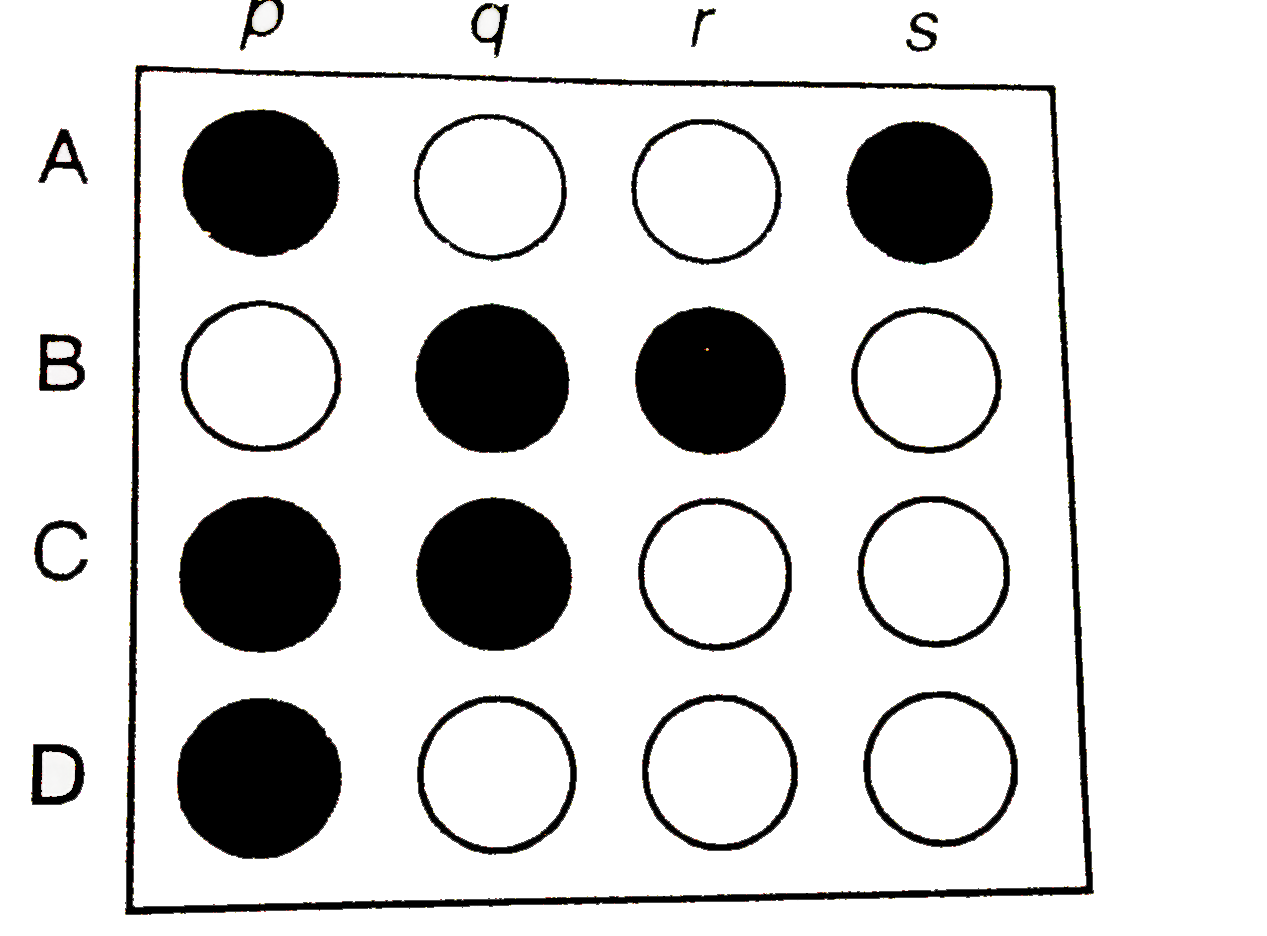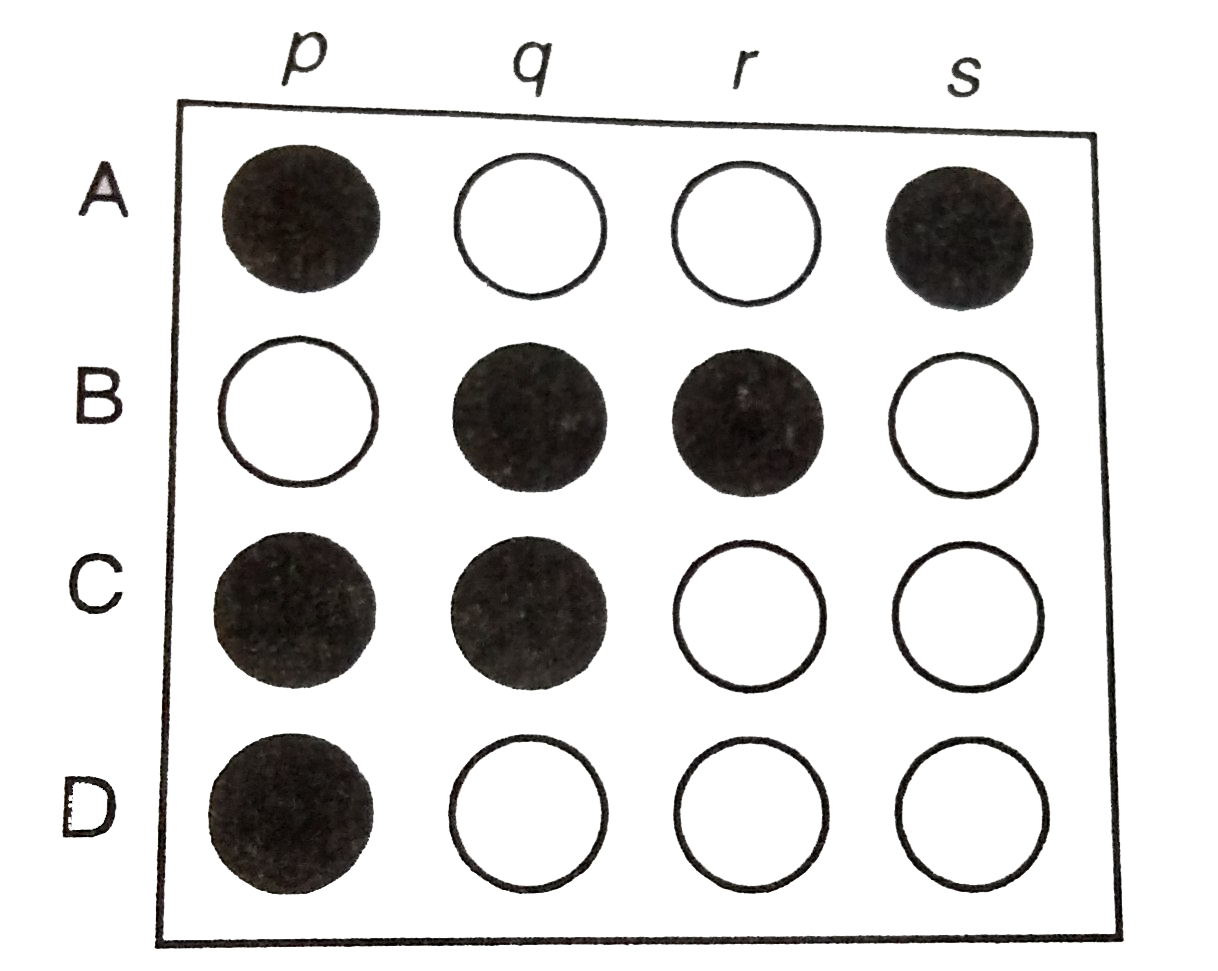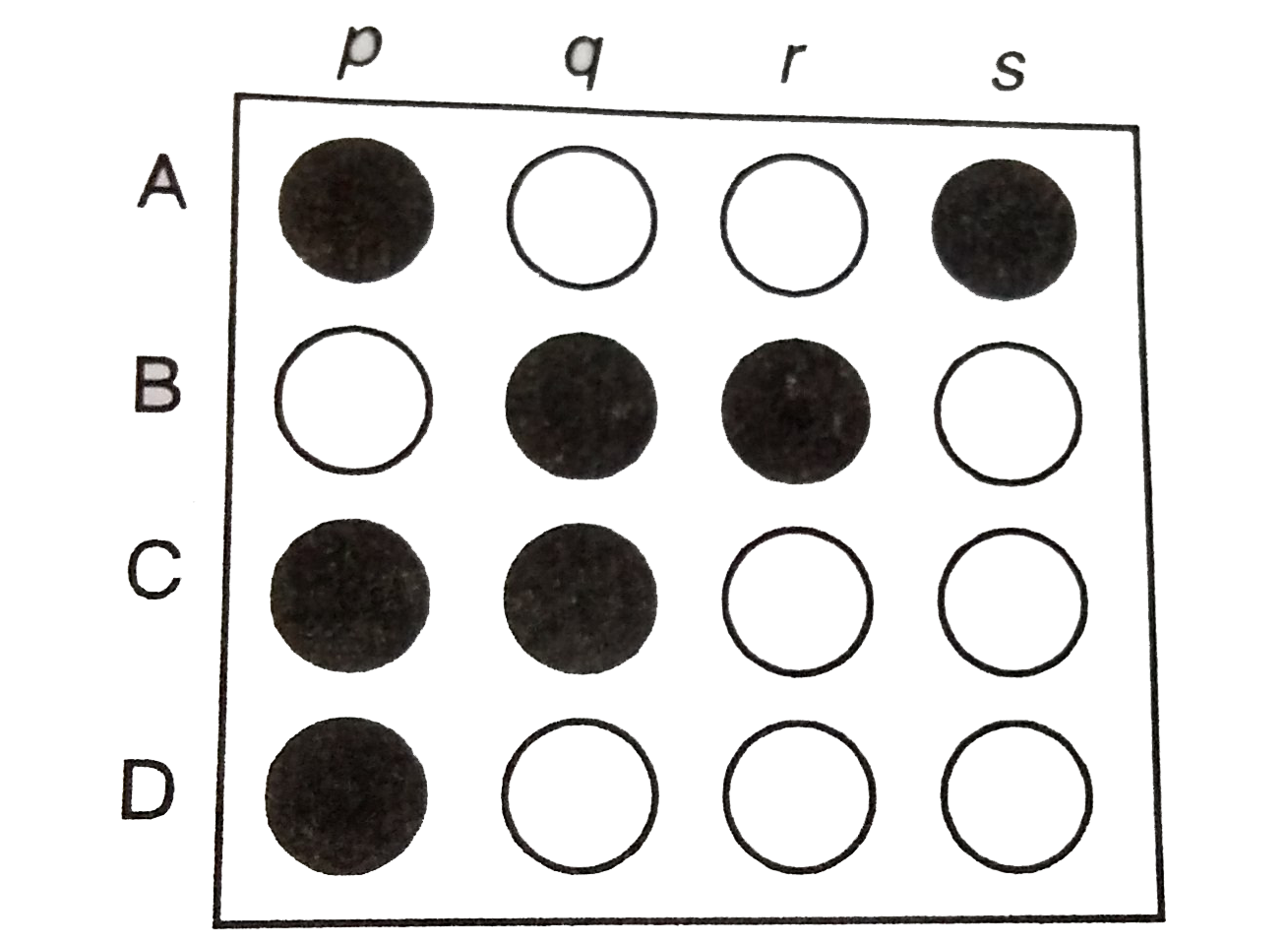Reason Assertion (A) Type MCQs from S DINESH & CO CHEMISTRY (HINGLISH) Chapter 31:SURFACE CHEMISTRY for Class 11
| Class 11 | CHEMISTRY |
| Chapter | SURFACE CHEMISTRY |
| S DINESH & CO CHEMISTRY (HINGLISH) | Reason Assertion (A) Type MCQs |
| Medium | English |
| Academic Year | 2023-2024 |
Question 176
Which among the following statement are correct with respect to adsorption of gases on a solid ?
(1) The extent of adsorption is equal to kpn according to Freundlich isotherm
(2) The extent of adsorption is equal to kp1/n according to Freundlich isotherm
(3) The extent of adsorption is equal (a+bp)ap according to Langmuir isotherm
The extent of adsorption is equal ap(1+bp) according to Langmuir isotherm
(5) Freundlich adsorption fails at a low pressureView SolutionQuestion 239
The amount of gas adsorbed (x/m) is the function of temperature and pressure, which can be shown as under
xm= f(p,T)
The variation x/m and p, at constant temperature is known as adsorption isotherm
i.e., x/m=f(p) at constant temperature
Seven type of physisorption isotherms are known. Some of them are shown below

Physisorption Type I. Where there is formation of monolayer on the surface of adsorbent, this type of curve is obtained.
Physisorption Type II. The transition point 'X' of this physisorption isotherm indicates, that the formation of mono layer is complete and that of multilayer is started.
Physisorption Type III. This isotherm has no transition point. In this type of curve, the multimolecular starts before the completion of monomolecular layer.
On the basis of this comprehension, answer teh following question from the physisorption isotherm of a gas on a solid shown as under.
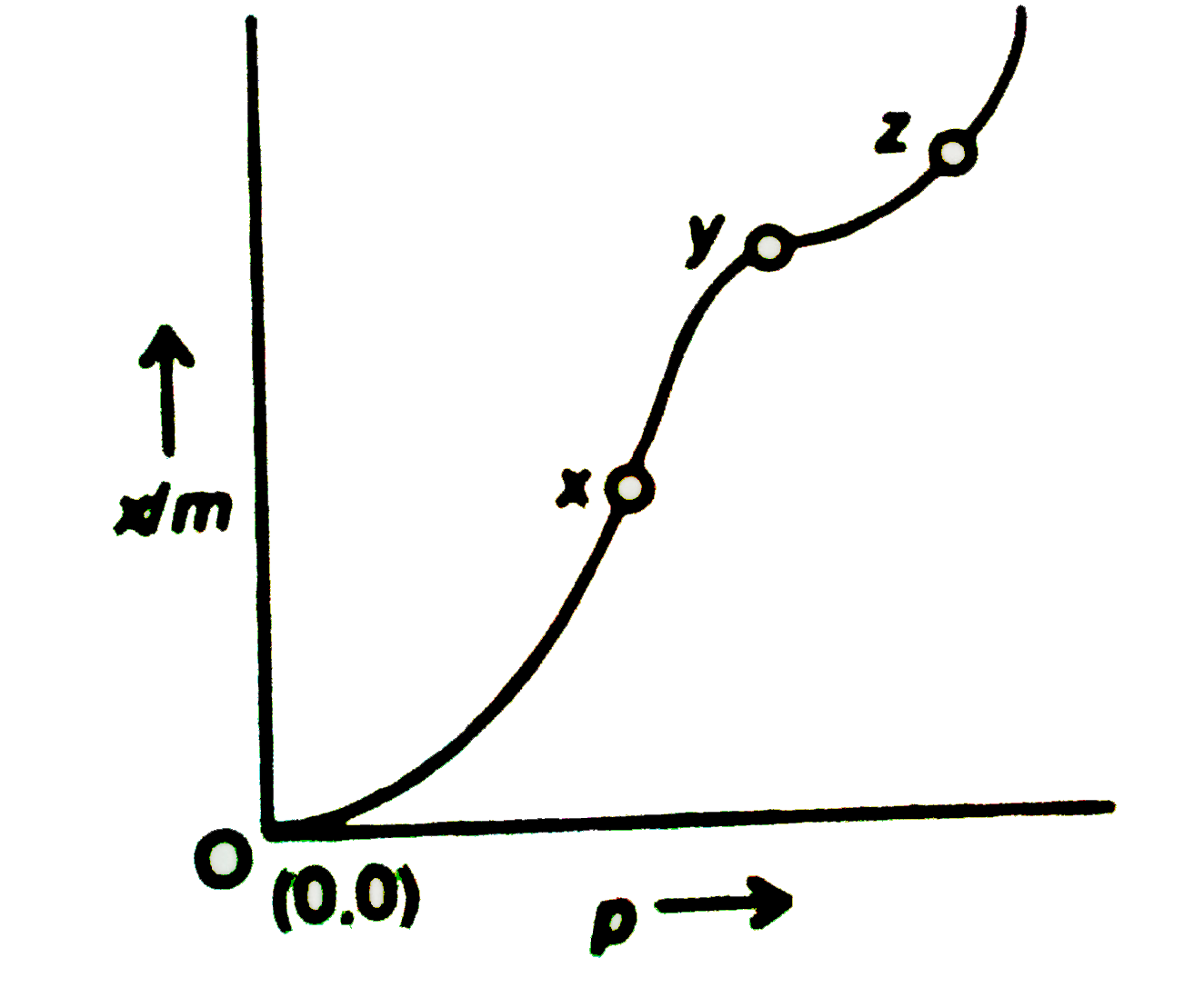
The portion ''OX'' of the physisorption isotherm representsView SolutionQuestion 240
The amount of gas adsorbed (x/m) is the function of temperature and pressure, which can be shown as under
xm= f(p,T)
The variation x/m and p, at constant temperature is known as adsorption isotherm
i.e., x/m=f(p) at constant temperature
Seven type of physisorption isotherms are known. Some of them are shown below

Physisorption Type I. Where there is formation of monolayer on the surface of adsorbent, this type of curve is obtained.
Physisorption Type II. The transition point 'X' of this physisorption isotherm indicates, that the formation of mono layer is complete and that of multilayer is started.
Physisorption Type III. This isotherm has no transition point. In this type of curve, the multimolecular starts before the completion of monomolecular layer.
On the basis of this comprehension, answer teh following question from the physisorption isotherm of a gas on a solid shown as under.
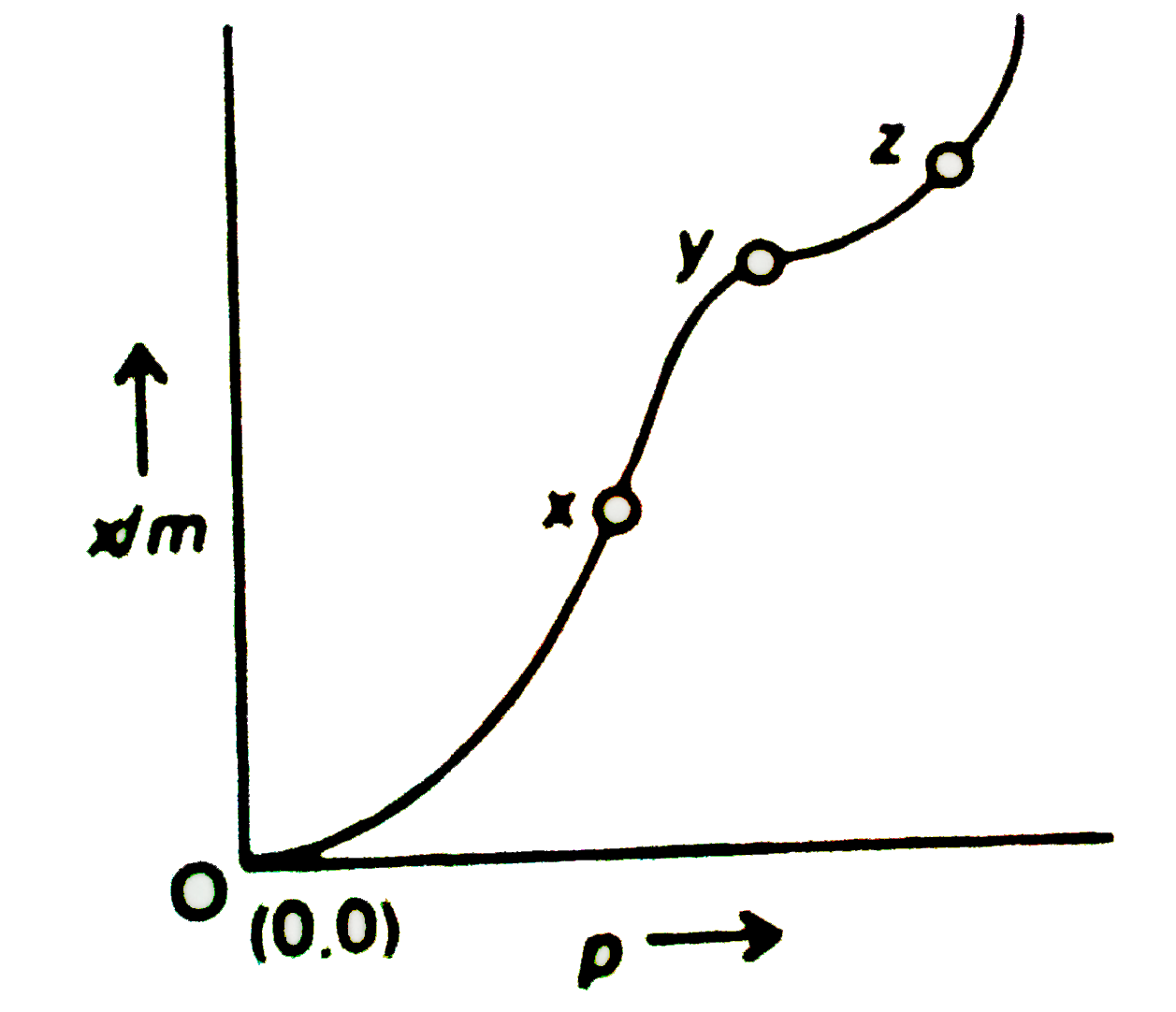
The portion XY of the curve correctly representsView SolutionQuestion 241
The amount of gas adsorbed (x/m) is the function of temperature and pressure, which can be shown as under
xm= f(p,T)
The variation x/m and p, at constant temperature is known as adsorption isotherm
i.e., x/m=f(p) at constant temperature
Seven type of physisorption isotherms are known. Some of them are shown below
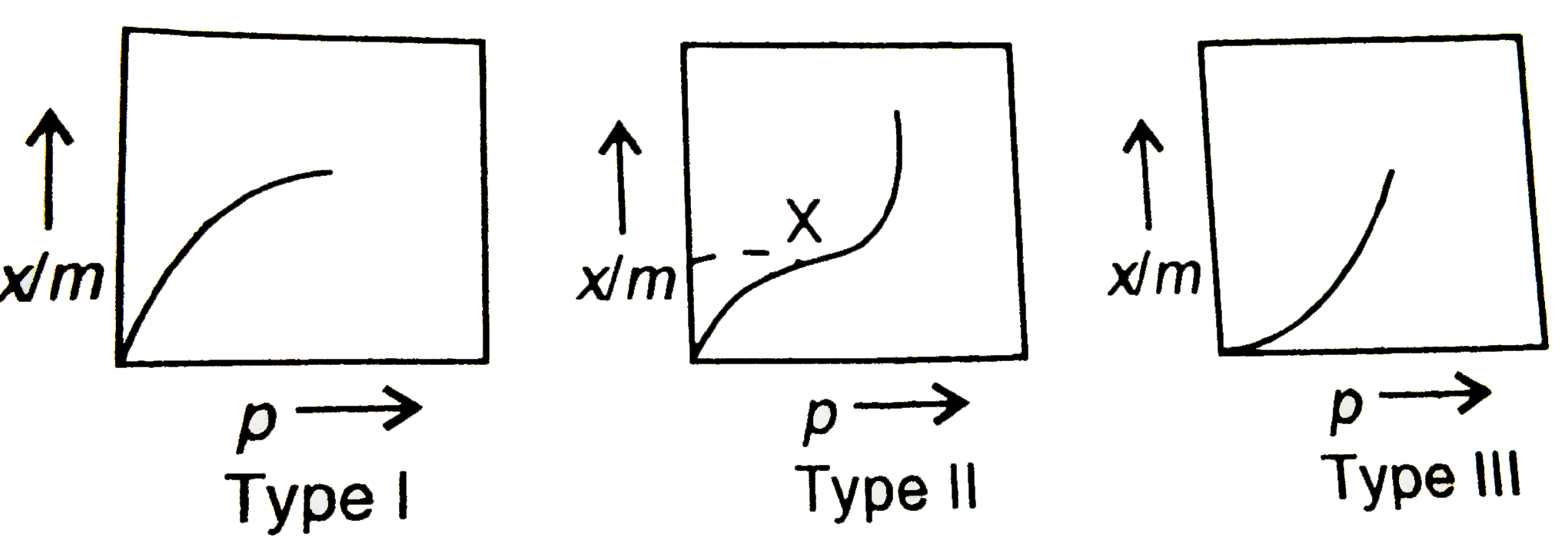
Physisorption Type I. Where there is formation of monolayer on the surface of adsorbent, this type of curve is obtained.
Physisorption Type II. The transition point 'X' of this physisorption isotherm indicates, that the formation of mono layer is complete and that of multilayer is started.
Physisorption Type III. This isotherm has no transition point. In this type of curve, the multimolecular starts before the completion of monomolecular layer.
On the basis of this comprehension, answer teh following question from the physisorption isotherm of a gas on a solid shown as under.
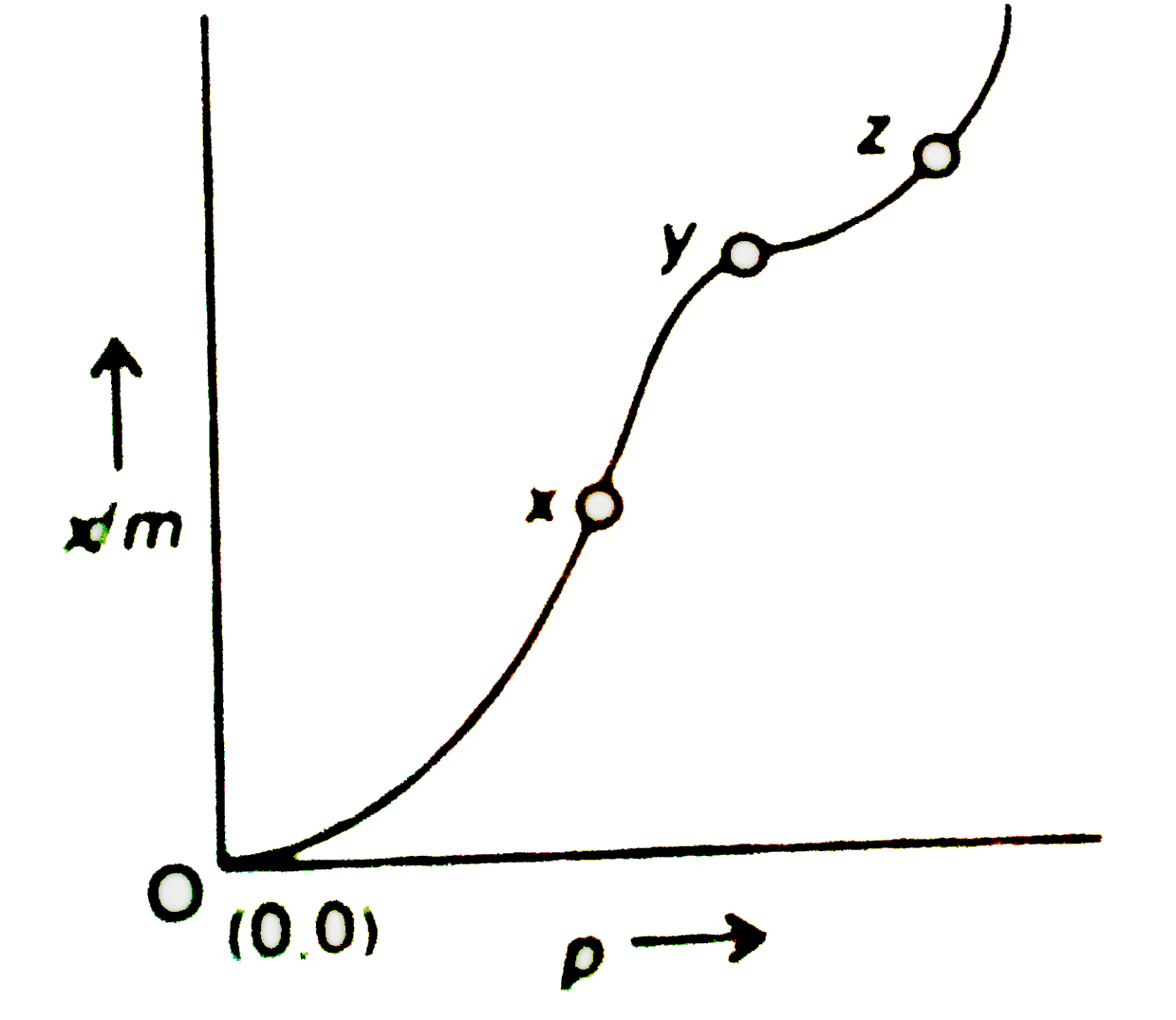
The point Y of physisorption isotherm correctly representsView SolutionQuestion 242
The amount of gas adsorbed (x/m) is the function of temperature and pressure, which can be shown as under
xm= f(p,T)
The variation x/m and p, at constant temperature is known as adsorption isotherm
i.e., x/m=f(p) at constant temperature
Seven type of physisorption isotherms are known. Some of them are shown below

Physisorption Type I. Where there is formation of monolayer on the surface of adsorbent, this type of curve is obtained.
Physisorption Type II. The transition point 'X' of this physisorption isotherm indicates, that the formation of mono layer is complete and that of multilayer is started.
Physisorption Type III. This isotherm has no transition point. In this type of curve, the multimolecular starts before the completion of monomolecular layer.
On the basis of this comprehension, answer teh following question from the physisorption isotherm of a gas on a solid shown as under.
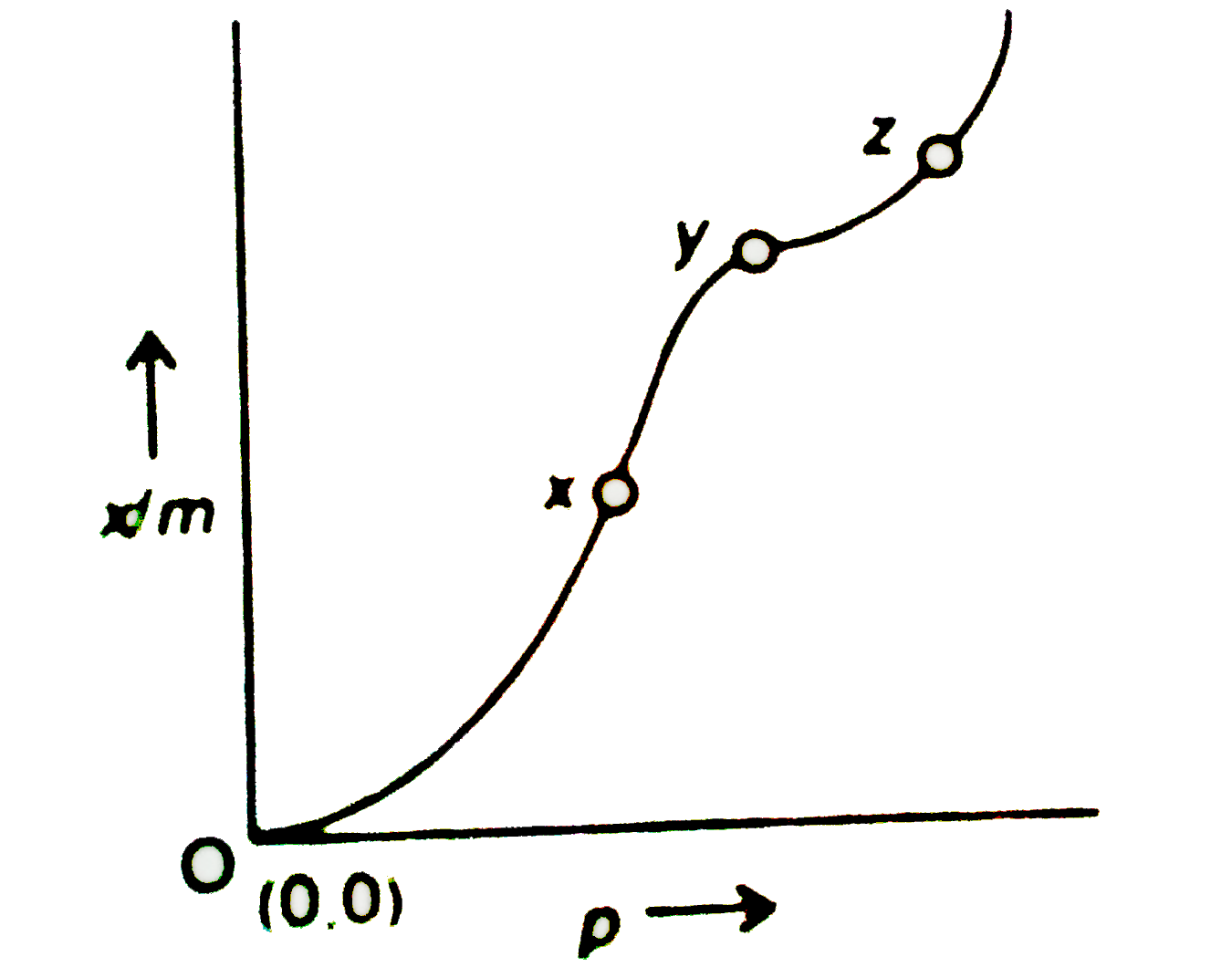
The point Z of the physisorption correctly represents View SolutionQuestion 243
In the macromolecular type of colloids, the dispersed particles are themselves large molecules (usually polymer). Since these molecules have dimesions comparable to those of colloidal particles, their dispersions are called macromolecular colloids. Most lyophilic sols belong to this category.
There are certain colloids which behave as normal strong electrolytes at low concentrations, but exhibit colloidal properties at higher concentrations due to the formation of aggergated particles. These are known as micelles associated colloids. Surface active agents like soaps and synthetic detergents belong to this class.
Critical micelle concentration ( C.M.C) is the lowest concentration at which micelle formation appears. C.M.C. increase with the total surfactant concentration. At the concentration higher than C.M.C. they form extended parallel sheets known as lamellar micelles which resemble biological membranes which are two molecules thick. The individual molecule is perpendicular to the sheets such that hydrophilic groups are on the outside in aqueous solution and hydrophobic on the inside in a nonpolar medium.
In concentrated solution, micelles take the form of long cylinders packed in hexagonal arrays and are called hytotropic mesomorphs .
in an aqueous solution (polar medium), the polar groups point toward the periphery and the hydrophobic hydrocarbon chains point toward the canter forming the core of the micelle.
Micelles from the ionic surfactants can be formed only above a certain temperature called the kraft temperature they are capable of forming ions molecules of soaps and detergents consist of lyophilic as well as lyophobic parts which associate together to form micelles. Micelles may contain as many as 100 molecules or more.
Select the incorrect statement (s)View SolutionQuestion 244
In the macromolecular type of colloids, the dispersed particles are themselves large molecules (usually polymer). Since these molecules have dimesions comparable to those of colloidal particles, their dispersions are called macromolecular colloids. Most lyophilic sols belong to this category.
There are certain colloids which behave as normal strong electrolytes at low concentrations, but exhibit colloidal properties at higher concentrations due to the formation of aggergated particles. These are known as micelles associated colloids. Surface active agents like soaps and synthetic detergents belong to this class.
Critical micelle concentration ( C.M.C) is the lowest concentration at which micelle formation appears. C.M.C. increase with the total surfactant concentration. At the concentration higher than C.M.C. they form extended parallel sheets known as lamellar micelles which resemble biological membranes which are two molecules thick. The individual molecule is perpendicular to the sheets such that hydrophilic groups are on the outside in aqueous solution and hydrophobic on the inside in a nonpolar medium.
In concentrated solution, micelles take the form of long cylinders packed in hexagonal arrays and are called hytotropic mesomorphs .
in an aqueous solution (polar medium), the polar groups point toward the periphery and the hydrophobic hydrocarbon chains point toward the canter forming the core of the micelle.
Micelles from the ionic surfactants can be formed only above a certain temperature called the kraft temperature they are capable of forming ions molecules of soaps and detergents consist of lyophilic as well as lyophobic parts which associate together to form micelles. Micelles may contain as many as 100 molecules or more.
Which part of soap (RCOO−) dissolves grease and forms micelle ?View SolutionQuestion 245
In the macromolecular type of colloids, the dispersed particles are themselves large molecules (usually polymer). Since these molecules have dimesions comparable to those of colloidal particles, their dispersions are called macromolecular colloids. Most lyophilic sols belong to this category.
There are certain colloids which behave as normal strong electrolytes at low concentrations, but exhibit colloidal properties at higher concentrations due to the formation of aggergated particles. These are known as micelles associated colloids. Surface active agents like soaps and synthetic detergents belong to this class.
Critical micelle concentration ( C.M.C) is the lowest concentration at which micelle formation appears. C.M.C. increase with the total surfactant concentration. At the concentration higher than C.M.C. they form extended parallel sheets known as lamellar micelles which resemble biological membranes which are two molecules thick. The individual molecule is perpendicular to the sheets such that hydrophilic groups are on the outside in aqueous solution and hydrophobic on the inside in a nonpolar medium.
In concentrated solution, micelles take the form of long cylinders packed in hexagonal arrays and are called hytotropic mesomorphs .
in an aqueous solution (polar medium), the polar groups point toward the periphery and the hydrophobic hydrocarbon chains point toward the canter forming the core of the micelle.
Micelles from the ionic surfactants can be formed only above a certain temperature called the kraft temperature they are capable of forming ions molecules of soaps and detergents consist of lyophilic as well as lyophobic parts which associate together to form micelles. Micelles may contain as many as 100 molecules or more.
In multimolecular colloidal sols, atoms or molecules are held together by View SolutionQuestion 246
In the macromolecular type of colloids, the dispersed particles are themselves large molecules (usually polymer). Since these molecules have dimesions comparable to those of colloidal particles, their dispersions are called macromolecular colloids. Most lyophilic sols belong to this category.
There are certain colloids which behave as normal strong electrolytes at low concentrations, but exhibit colloidal properties at higher concentrations due to the formation of aggergated particles. These are known as micelles associated colloids. Surface active agents like soaps and synthetic detergents belong to this class.
Critical micelle concentration ( C.M.C) is the lowest concentration at which micelle formation appears. C.M.C. increase with the total surfactant concentration. At the concentration higher than C.M.C. they form extended parallel sheets known as lamellar micelles which resemble biological membranes which are two molecules thick. The individual molecule is perpendicular to the sheets such that hydrophilic groups are on the outside in aqueous solution and hydrophobic on the inside in a nonpolar medium.
In concentrated solution, micelles take the form of long cylinders packed in hexagonal arrays and are called hytotropic mesomorphs .
in an aqueous solution (polar medium), the polar groups point toward the periphery and the hydrophobic hydrocarbon chains point toward the canter forming the core of the micelle.
Micelles from the ionic surfactants can be formed only above a certain temperature called the kraft temperature they are capable of forming ions molecules of soaps and detergents consist of lyophilic as well as lyophobic parts which associate together to form micelles. Micelles may contain as many as 100 molecules or more.
Select the correct statement about phopholipids View SolutionQuestion 247
In the macromolecular type of colloids, the dispersed particles are themselves large molecules (usually polymer). Since these molecules have dimesions comparable to those of colloidal particles, their dispersions are called macromolecular colloids. Most lyophilic sols belong to this category.
There are certain colloids which behave as normal strong electrolytes at low concentrations, but exhibit colloidal properties at higher concentrations due to the formation of aggergated particles. These are known as micelles associated colloids. Surface active agents like soaps and synthetic detergents belong to this class.
Critical micelle concentration ( C.M.C) is the lowest concentration at which micelle formation appears. C.M.C. increase with the total surfactant concentration. At the concentration higher than C.M.C. they form extended parallel sheets known as lamellar micelles which resemble biological membranes which are two molecules thick. The individual molecule is perpendicular to the sheets such that hydrophilic groups are on the outside in aqueous solution and hydrophobic on the inside in a nonpolar medium.
In concentrated solution, micelles take the form of long cylinders packed in hexagonal arrays and are called hytotropic mesomorphs .
in an aqueous solution (polar medium), the polar groups point toward the periphery and the hydrophobic hydrocarbon chains point toward the canter forming the core of the micelle.
Micelles from the ionic surfactants can be formed only above a certain temperature called the kraft temperature they are capable of forming ions molecules of soaps and detergents consist of lyophilic as well as lyophobic parts which associate together to form micelles. Micelles may contain as many as 100 molecules or more.
Cleansing action of soap occurs becauseView SolutionQuestion 248
In the macromolecular type of colloids, the dispersed particles are themselves large molecules (usually polymer). Since these molecules have dimesions comparable to those of colloidal particles, their dispersions are called macromolecular colloids. Most lyophilic sols belong to this category.
There are certain colloids which behave as normal strong electrolytes at low concentrations, but exhibit colloidal properties at higher concentrations due to the formation of aggergated particles. These are known as micelles associated colloids. Surface active agents like soaps and synthetic detergents belong to this class.
Critical micelle concentration ( C.M.C) is the lowest concentration at which micelle formation appears. C.M.C. increase with the total surfactant concentration. At the concentration higher than C.M.C. they form extended parallel sheets known as lamellar micelles which resemble biological membranes which are two molecules thick. The individual molecule is perpendicular to the sheets such that hydrophilic groups are on the outside in aqueous solution and hydrophobic on the inside in a nonpolar medium.
In concentrated solution, micelles take the form of long cylinders packed in hexagonal arrays and are called hytotropic mesomorphs .
in an aqueous solution (polar medium), the polar groups point toward the periphery and the hydrophobic hydrocarbon chains point toward the canter forming the core of the micelle.
Micelles from the ionic surfactants can be formed only above a certain temperature called the kraft temperature they are capable of forming ions molecules of soaps and detergents consist of lyophilic as well as lyophobic parts which associate together to form micelles. Micelles may contain as many as 100 molecules or more.
2.56 g of sulphur (colloidal sulphur) in 100mL solution shows osmotic pressure of 2.463 atm at 27∘C. How many sulphur atoms are associated in a colloidal sol ?
(Solution constant =0.0821 L atm mol−1K−1)View SolutionQuestion 260
Assertion (A) : Smoke consists of unburnt electrically charged carbon articles dispersed in waste gases. But the smoke coming out from the chimney of the factory is free from carbon particles.
Reason (R): The smoke is passed through the charged plates before allowing it to escape out of the chimney, when the charged particles of carbon get discharged.View SolutionQuestion 264
Assertion (A) : When freshly precipitated nickel sulphide (NiS) is shaken with a solution of hydrogen sulphide, a colloidal sol. is obtained .
Reason (R): The cause of peptization is the development of positive or negative charge on the precipitates by selective adsorption of ions from electrolytes. View Solution
All Exercises from S DINESH & CO CHEMISTRY (HINGLISH) Class 11 CHEMISTRY SURFACE CHEMISTRY
- COLLOIDAL STATE
- INTEGER TYPE QUESTION
- LINKED COMPREHENSION TYPE MCQS
- MATRIX MATCH TYPE MCQS
- MCQ WITH ONLY ONE CORRECT ANSWER
- MULTIPLE CHOICE QUESTIONS (ADSORPTION)
- REASON ASSERTION (A) TYPE MCQS
- REVISION QUESTION FROM COMPETITIVE EXAMS
- SELECTED STRAIGHT OBJECTIVE TYPE MCQ S
- ULTIMATE PREPATARORY PACKAGE
- COLLOIDAL STATE
- INTEGER TYPE QUESTION
- LINKED COMPREHENSION TYPE MCQS
- MATRIX MATCH TYPE MCQS
- MCQ WITH ONLY ONE CORRECT ANSWER
- MULTIPLE CHOICE QUESTIONS (ADSORPTION)
- REASON ASSERTION (A) TYPE MCQS
- REVISION QUESTION FROM COMPETITIVE EXAMS
- SELECTED STRAIGHT OBJECTIVE TYPE MCQ S
- ULTIMATE PREPATARORY PACKAGE
- COLLOIDAL STATE
- INTEGER TYPE QUESTION
- LINKED COMPREHENSION TYPE MCQS
- MATRIX MATCH TYPE MCQS
- MCQ WITH ONLY ONE CORRECT ANSWER
- MULTIPLE CHOICE QUESTIONS (ADSORPTION)
- REASON ASSERTION (A) TYPE MCQS
- REVISION QUESTION FROM COMPETITIVE EXAMS
- SELECTED STRAIGHT OBJECTIVE TYPE MCQ S
- ULTIMATE PREPATARORY PACKAGE
- COLLOIDAL STATE
- INTEGER TYPE QUESTION
- LINKED COMPREHENSION TYPE MCQS
- MATRIX MATCH TYPE MCQS
- MCQ WITH ONLY ONE CORRECT ANSWER
- MULTIPLE CHOICE QUESTIONS (ADSORPTION)
- REASON ASSERTION (A) TYPE MCQS
- REVISION QUESTION FROM COMPETITIVE EXAMS
- SELECTED STRAIGHT OBJECTIVE TYPE MCQ S
- ULTIMATE PREPATARORY PACKAGE
